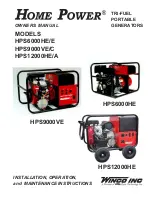
8199-00
Page 4
60707-117
UNIT PREPARATION
Before your engine generator was shipped from our factory
it was fully checked for performance. The generator was
load tested to its full capacity, and the voltage and
frequency were carefully checked and adjusted.
OPERATING LOCATION
DANGER: DEATH AND DISABILITY
DO NOT operate or install these units inside any
building or structure. These units produce carbon
monoxide on all three of the operating fuels. Carbon
monoxide can kill or disable a person in a very short
time. In addition, never operate these units in a
location that will allow the carbon monoxide (exhaust)
to seep into a building that is occupied.
The engine-generator models covered in this manual were
designed for portable use. The unit should be stored in a
dry location. During a power outage move the unit outdoors
to a flat dry location such as a driveway, concrete pad or
sidewalk for use. We recommend installing the optional
dolly kit or equivalent for ease of handling.
LUBRICATION
Before starting the engine, fill the crankcase to the proper
level with a good quality oil. When filling the crankcase
with oil use the dipstick, there is some trapped oil in the
engine. The recommended grade of oil and quantity of oil
required is listed in the engine operator's manual. The
necessity of using the correct oil, and keeping the crankcase
full cannot be overemphasized. Engine failures resulting
from inadequate or improper lubricant are considered abuse
and are not covered by the generator or the engine
manufacturer's warranty.
WARNING - Never overfill the crankcase with oil. If the
crankcase is overfilled with oil the excess oil will be push out
through the breather resulting in oil in the carburetor and air
filter.
BATTERY INSTALLATION
If you intend to use the power plant’s electric start system,
(required if you are intending to use either LP or NG Fuel)
you will need to purchase a battery to operate it. Units
equipped with a recoil or rope start will operate satisfactorily
without a battery on gasoline only.
Installation and servicing of batteries must be performed or
supervised only by personnel knowledgeable of batteries and
the required precautions. Keep unauthorized personnel
away from batteries.
When installing or replacing batteries, use the proper group/
size starting battery. The battery should be a Maintenance
Free lead acid design. Deep cycle batteries will not work for
this application.
Model
BCI Group
Capability (minimum)
HPS6000HE
U1
275 CCA
HPS9000E
U1
275 CCA
HPS12000HE
U1
300 CCA
CAUTION – PERSONAL DANGER
NEVER dispose of a battery in a fire. The battery is capable
of exploding.
DO NOT open or mutilate the battery. Released electrolyte
is known to be harmful to the skin and eyes and to be very
toxic.
These engine generator sets are all NEGATIVE ground. Be
very careful not to connect the battery in reverse polarity, as
this may short circuit the battery charging system on the
engine.
CAUTION – A battery presents a risk of electrical shock and
high short circuit current. The following precautions must be
observed when working with batteries.
1.
Remove watches, rings and other metal objects.
2.
Use tools with insulated handles.
3.
Check both the battery cable ends and the battery
posts to be sure they are free of corrosion.
3.
Always connect the battery positive cable first and
then connect the battery negative cable. When
removing the battery cables from the battery reverse
the procedure, disconnect the negative cable first and
then the positive cable.
4.
Be sure all connections are tight and coat the
terminals and cable end with dialectic grease.
WARNING – The electrolyte is a diluted sulfuric acid that is
harmful to the skin and eyes. It is electrically conductive
and corrosive. The following precautions must always be
taken.
*
Always wear full eye protection and protective
clothing
*
Where electrolyte contacts the skin, wash off
immediately with water.
*
If electrolyte contacts the eyes, flush thoroughly
and immediately with water and seek immediate
medical attention.
*
Spilled electrolyte is to be washed down with an
acid neutralizing agent. A common practice is to
use a solution of one pound of bicarbonate of soda
(baking soda) to one gallon of water. The
bicarbonate of soda solution is to be added until
the evidence of reaction, foaming, has ceased.
The resulting liquid is to be flushed with water and
the area dried.


































